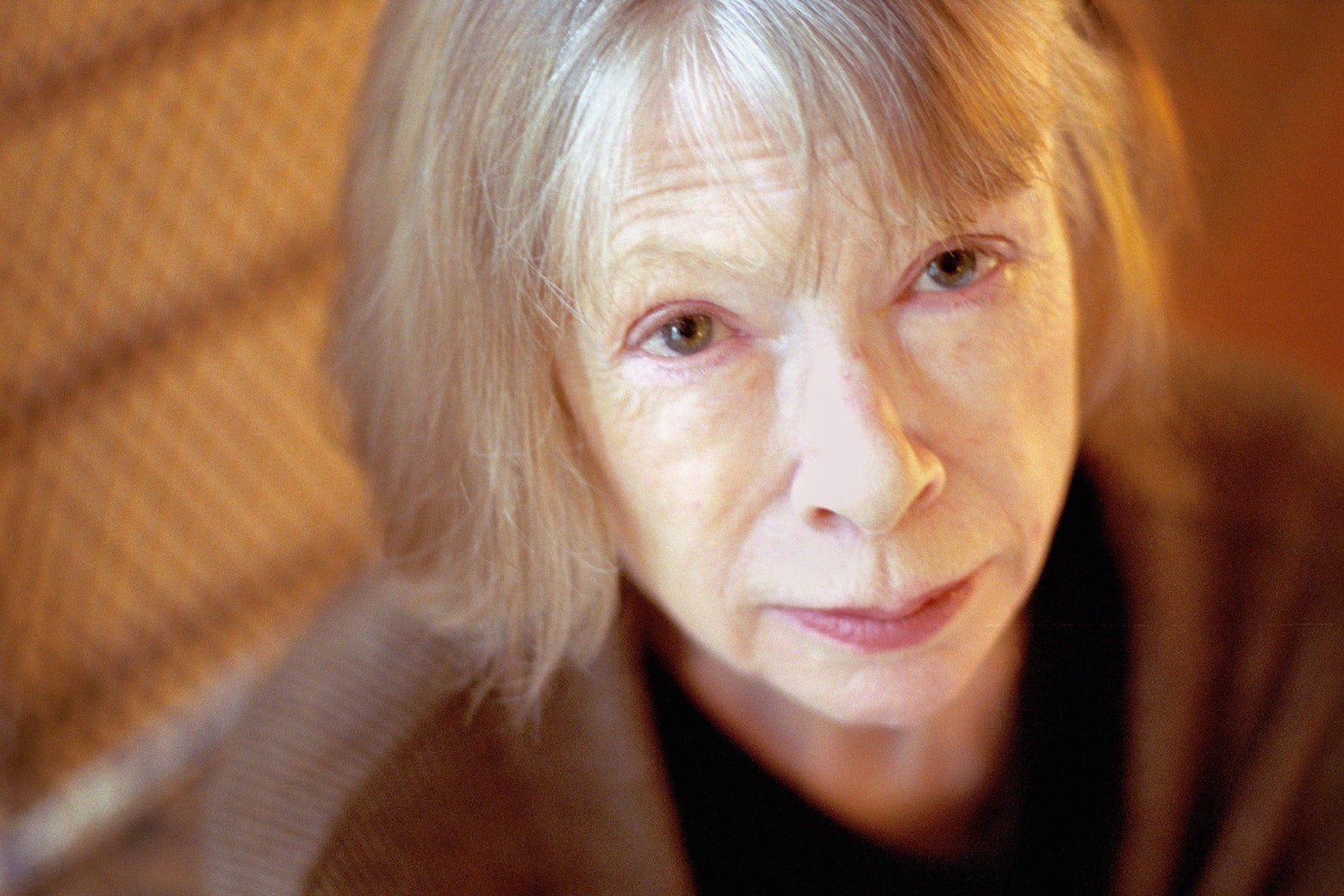
By some uncanny irony that she surely would have appreciated, the moment I learned of Joan Didion’s death on Thursday, a migraine aura bloomed in my field of vision, a crescent of dancing silver triangles that prevented me from reading the first obituaries for about 15 minutes. Didion wrote a famous essay about her migraines, and many times, upon learning that I get them too, people would ask if I’d ever read it. I still haven’t. It’s too close for comfort. If you get migraines, the last thing you want to think about when you don’t have a migraine is migraines. The fact that Didion chose to write about hers, however, has always impressed me. Who, having visited that queasy, buzzing, panicky world, would ever have the fortitude to revisit it in memory long enough to properly describe it? She would, of course.
Raised in the dowdiest of California cities, Sacramento, to become a genteel, provincial society wife, Didion remade herself as a chronicler—in fiction, essays, and journalism—of bilious states. She wrote about L.A. in the apocalyptic, speed-abraded 1970s; about tiny Central American nations poisoned by the proxy battles of the Cold War; about the soulless theatrics of political conventions and the slavering, racist ecstasies of New York tabloid journalism. Most famously, she wrote about the hallucinatory limbo of grief in her National Book Award–winning memoir, The Year of Magical Thinking, recounting the psychic aftermath of the sudden death of her husband of 39 years, John Gregory Dunne. It was her most successful book financially, perhaps because the numbing unreality of losing someone dearly loved is one of the few times in a life span that we all sojourn though Didionland.
Joan Didion was a mood, the static in the air before an earthquake, the sense that your footing is crumbling beneath you. She started out as a John Wayne–worshipping Goldwater Republican and ended up criticizing U.S. foreign policy and debunking the case against the Central Park Five in the New York Review of Books. Her signature style, honed and hardened by disillusionment and a profound mistrust of sentimentality in all its forms, was both a repudiation of her roots and a veiled embrace of its frontier toughness. Descended from the survivors of the Donner Party, she prided herself on facing brutal truths, even when one of those truths is that the mythos that gave your ancestors the will to carry on was just another sham.
She produced a number of much-quoted lines, from “We tell ourselves stories in order to live” (not the bromide about the life-giving power of fiction it’s typically taken to be) and “Writers are always selling somebody out” (which is quintessential Didion). One of those lines, “Style is character,” from an interview with the Paris Review, seemed to capture her own ethos best. Her first real job was in New York, at Vogue, where, she always maintained, she learned to write with the utmost of compression and economy. By the end of her career, Didion was as much an icon for her persona as for her writings, hired by Celine to model sunglasses in magazine ads and adored by young women writers for her chic sangfroid as well as her prose. Photos taken of Didion in Los Angeles in 1968 in a long dress, cigarette in hand, leaning against her yellow Corvette, captured an idea about female artistry, simultaneously fragile and impenetrable, balanced on the verge of a nervous breakdown and a Nobel Prize, that, while clearly no fun—photos of Didion smiling are vanishingly rare—nevertheless felt enviably cool.
In that same Paris Review interview, Didion explained that despite writing from her early childhood, at first she wanted to be an actress, like the main character of her best-known novel, Play It as It Lays. “It’s the same impulse,” she said. “It’s make-believe. It’s performance.” The great movie stars of Didion’s era exerted a particular kind of charisma that she, too, mastered. It’s the art of offering your whole self up to the camera or the page and yet also holding something back. Didion’s restraint and discipline as a writer served as more than just the container for the various species of chaos she wrote about. It also gestured toward the unsaid, the part of herself she kept forever in reserve. Few actors can finesse this paradox, and even fewer writers. Didion herself didn’t always pull it off smoothly. After The Year of Magical Thinking, she published 2011’s Blue Nights, an account of her daughter’s death that, according to her biographer, Tracy Daugherty, attracted criticism for shying away from a full account of the cause of that death. That omission pointed, perhaps, toward where her true vulnerabilities lay.
Such slips were rare, however, and even in her confessional mode, Didion always felt elusive. That was what made us want to follow her across the assortment of blasted heaths she visited, surveyed, and dissected with the chilliest aplomb. There was the precision of her prose and then there was the mystery of the woman who chipped it out of ice, so pure and translucent it seemed like a natural phenomenon. Like all the best mysteries, it will never be solved.
source: https://slate.com/culture/2021/12/joan-didion-death-obituary-magical-thinking.html
Your content is great. However, if any of the content contained herein violates any rights of yours, including those of copyright, please contact us immediately by e-mail at media[@]kissrpr.com.
